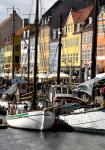It was an exciting time for India and the world.
Photography had been invented 50 years earlier, and the mass-produced Kodak camera of the 1880s helped democratise photography.
Ritika Kochhar reports on an unusual exhibition of postcards that chronicle life in the British Raj.

If you look carefully, you can find fascinating stories in mundane things like matchboxes, labels... And even postcards.

For example, one of the nuggets of information gleaned from an early 20th-century European postcard is that, even at the height of British rule in India, one pound sterling was worth 15 rupees.

Another postcard, a photograph of English people and their staff on a houseboat in Srinagar, explains that houseboats became popular because the Maharaja of Kashmir wouldn't let outsiders buy property in his state.

These postcards feature in a recently published book, Paper Jewels: Postcards from the Raj by Omar Khan, visuals from which are on display at an eponymous travelling exhibition.

On view now at Mumbai's Dr Bhau Daji Lad Museum, the exhibition focuses on postcards from India during the first half of the 20th century.

It is curated by Khan and Rahaab Allana of the Alkazi Foundation for the Arts, and relies almost entirely on Khan's personal collection.

New research in archives and private collections in India, Pakistan, Europe and the US bolsters Khan's collection to tell a nuanced story about the changing face of Bombay, industrialisation, tourism and, eventually, the rise of the nationalist movement in the last 50 years of the Raj in India.

It was an exciting time for India and the world. Photography had been invented 50 years earlier, and the mass-produced Kodak camera of the 1880s helped democratise photography.

The imperial project opened up travel, and newly created technologies like lithography allowed small workshops and artisans to become entrepreneurs.

The illustrated postcard became the world's first mass transmission of colour images and enabled communication between families, friends and businesses anywhere in the world, leading to the sale of billions of postcards.

The finest painters and graphic artists became involved in the birth of this new media form, including M V Dhurandhar, head of the famed J J School of Art in Bombay, who also came to be regarded as the greatest postcard artist of Bombay.

A separate section is devoted to the postcards made by this largely forgotten artist who during his life received every conceivable honour from the British. "So much of Dhurandhar's work relates to the community and puts the people in perspective," says Tasneem Mehta, honorary director at the museum.

The growing nationalistic fervour also meant that many Indians wanted to work with Germans and Austrians rather than the British; Erwin Neumayer and Christine Schelberger wrote in a biography of Raja Ravi Varma that the working language of his famous printing press in Bombay was German.

Indeed, most postcards were first printed in Germany and Austria, with photographs being sent to Dresden by publishers in India, and postcards made by printers there shipped back to be sold to international tourists for a few annas or pennies.

The exhibition, with its 300 postcards, old photographs, albums and clay models, offers an accessible treat.

In addition, around 3,000 professionally restored postcards from British India, Pakistan, Sri Lanka (Ceylon) and Myanmar (Burma) have been released online by the author and the Alkazi Foundation of the Arts under a free and open Creative Commons license on the Internet Archive.
Paper Jewels: Postcards from the Raj is on at the Dr Bhau Daji Lad Museum, Mumbai, till October 1. It will move to the Art Heritage Gallery, Delhi (October 17-November 17) and the Serendipity Arts Festival, Goa (December 15-December 22).












